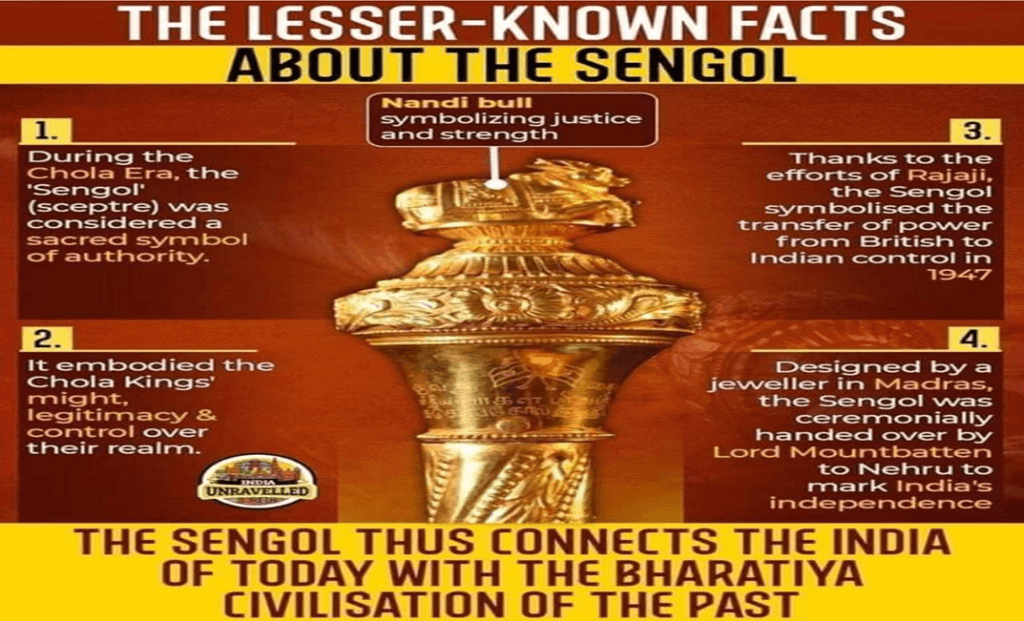The Sengol, also known as the sceptre, holds great historical significance as it symbolizes the transfer of power from the British to the Indians during India’s independence in 1947. Here are some important points regarding the historical significance of the Sengol:
Origin and Cultural Importance:
- The origin of the Sengol can be traced back to the Chola dynasty, which was one of the longest-ruling dynasties in the world, based in South India.
- During the rule of the Chola dynasty, the transfer of power was conducted in the presence of a priest, and it was sanctified with the Sengol.
- The Sengol has become an integral part of Tamil Nadu’s cultural heritage and tradition, being used in various cultural events, festivals, and important ceremonies.
The Transfer of Power Ceremony of 1947:
The transfer of power ceremony held in 1947 played a significant role in shaping the history of India. Here are some key details about this historic event:
- Lord Mountbatten’s Inquiry:
- Lord Mountbatten, the last Viceroy of India, inquired with Jawaharlal Nehru about the ceremony that should be followed to symbolize the transfer of power from British to Indian hands.
- Inspiration from the Chola Dynasty:
- C. Rajagopalachari, the last Governor-General of India, shared with Nehru a ceremony practiced during the Chola dynasty, in which the transfer of power was sanctified and blessed by high priests.
- The symbol used for the transfer of power during this ceremony was the handover of the Sengol from one king to his successor.
- Arrangement of the Sengol:
- Rajagopalachari took the responsibility of arranging a sceptre and approached Thiruvaduthurai Atheenam, a renowned mutt in Tamil Nadu’s Tanjore district.
- The leader of the mutt commissioned the manufacturing of the Sengol to the Chennai-based jewellers, “Vummidi Bangaru Chetty.”
- The Sengol was skillfully constructed by two men named Vummidi Ethirajulu and Vummidi Sudhakar.
- The Transfer of Power:
- During the ceremony on August 14, 1947, a priest presented the sceptre to Lord Mountbatten, who then returned it.
- The Sengol was then taken in a procession to Pt. Jawaharlal Nehru’s house, where it was officially handed over to him, symbolizing the transfer of power.
- Cultural Significance:
- To add cultural significance to the event, a special song called Kolaru Padhigam, composed by the 7th-century Tamil saint Tirugnana Sambandar, was rendered during the ceremony.
- The ceremony was also attended by Rajendra Prasad, the first President of India, adding to its historical importance.

Important Points:
- The Sengol (sceptre) symbolizes the transfer of power from the British to the Indians in 1947. 💫
- The Sengol’s origin can be traced back to the Chola dynasty of South India. 🏰
- During the Chola dynasty, power transfers were sanctified with the Sengol, reminding the king to rule with justice. ⚖️
- The Sengol is an integral part of Tamil Nadu’s heritage and tradition, being used in cultural events, festivals, and ceremonies. 🎉
- Lord Mountbatten inquired about a ceremony to symbolize the transfer of power. 🤔
- C. Rajagopalachari shared a ceremony from the Chola dynasty involving the Sengol. 💡
- The Sengol was arranged by Rajagopalachari and commissioned to Vummidi Bangaru Chetty jewelers. 💍
- The Sengol was crafted by Vummidi Ethirajulu and Vummidi Sudhakar. 🔨
- During the 1947 ceremony, the Sengol was given to Lord Mountbatten and then handed over to Jawaharlal Nehru. 🤝
- The event featured the rendering of the Kolaru Padhigam song composed by Tirugnana Sambandar. 🎶
- Rajendra Prasad, the first President of India, attended the ceremony. 🇮🇳
- The Sengol represents the historical transfer of power during India’s independence. 🌟
- The ceremony drew inspiration from the practices of the Chola dynasty. 🏛️
- The Sengol continues to hold cultural significance in Tamil Nadu. 🌺
Why In News
The New Parliament, a magnificent architectural marvel, will proudly accommodate the Sceptre (Sengol) which symbolizes the historic transfer of power in 1947. This iconic relic will serve as a tangible reminder of the struggles and triumphs that have shaped our nation’s democratic journey.
MCQs about The Historical Significance of the Sengol
-
What does the Sengol symbolize in Indian history?
A. The rise of the Chola dynasty
B. The transfer of power from the British to the Indians
C. The cultural heritage of Tamil Nadu
D. The significance of traditional ceremonies
-
From which dynasty does the Sengol originate?
A. Maurya dynasty
B. Gupta dynasty
C. Chola dynasty
D. Vijayanagara dynasty
-
Who was responsible for arranging the Sengol during the transfer of power ceremony?
A. Lord Mountbatten
B. Jawaharlal Nehru
C. C. Rajagopalachari
D. Rajendra Prasad
-
What song was rendered during the 1947 ceremony involving the Sengol?
A. Vande Mataram
B. Jana Gana Mana
C. Kolaru Padhigam
D. Sare Jahan se Accha
Boost up your confidence by appearing our Weekly Current Affairs Multiple Choice Questions
![]()


